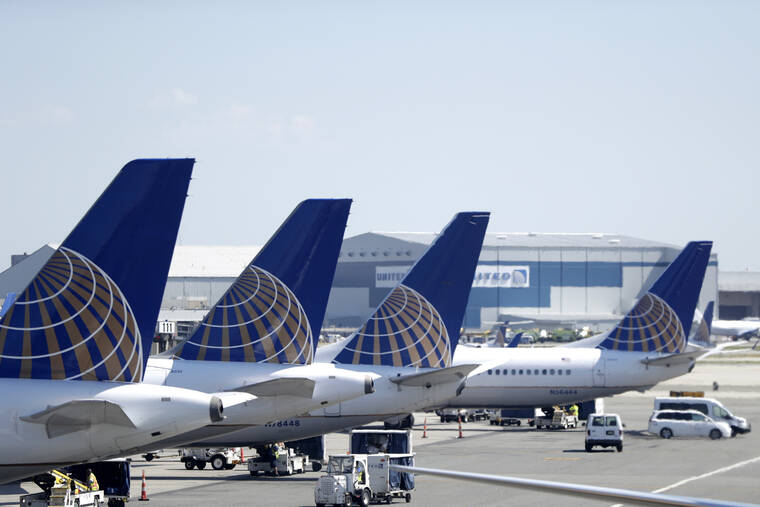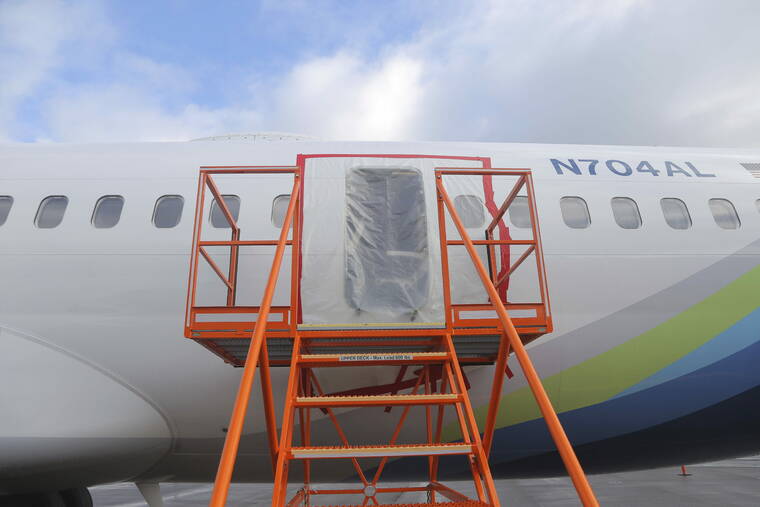United found loose bolts, other issues on Boeing 737 Max 9 jets


ASSOCIATED PRESS / 2018
United Airlines jets sit at a gate at Terminal C of Newark Liberty International Airport in Newark, N.J.

ASSOCIATED PRESS
This photo released by the National Transportation Safety Board shows a gaping hole where the paneled-over door had been at the fuselage plug area of Alaska Airlines Flight 1282 on Sunday, Jan. 7, 2024, in Portland, Ore. A panel used to plug an area reserved for an exit door on the Boeing 737 Max 9 jetliner blew out Jan. 5, shortly after the flight took off from Portland, forcing the plane to return to Portland International Airport.

ASSOCIATED PRESS
On a personal electronic GPS, Beaverton, Ore., resident Adam Pirkle shows the 14 miles he rode on his bicycle in his neighborhood and around southwest Portland, Ore., Sunday, Jan. 7, 2024, looking for the fuselage of a Boeing 737 Max 9 that detached shortly after the takeoff of an Alaska Airlines flight on Friday, Jan. 5. The National Transportation Safety Board estimated the fuselage may have fallen in the area.




PORTLAND, Ore. >> United Airlines said today it found loose bolts and other “installation issues” on a part of some Boeing 737 Max 9 jets that were inspected after a mid-flight fuselage blowout on a similar Alaska Airlines jet Friday.
The inspections are focused on plugs used to seal an area set aside for extra emergency doors that are not required on United and Alaska Max 9s. That plug is the part that blew off the Alaska plane as it cruised 16,000 feet (4,900 meters) over Oregon.
“Since we began preliminary inspections on Saturday, we have found instances that appear to relate to installation issues in the door plug – for example, bolts that needed additional tightening,” Chicago-based United said.
The Federal Aviation Administration grounded all Max 9s operated by Alaska and United and some flown by foreign airlines after the terrifying flight on Friday night that left a gaping hole in the fuselage. The plane, which had been heading for Southern California, made it back to Portland and none of the 171 passengers and six crew members was seriously injured.
The Boeing jetliner that suffered the blowout over Oregon had already been restricted from being used for flights to Hawaii after a warning light that could have indicated a pressurization problem lit up on three previous flights.
Alaska Airlines decided not to let the aircraft make long flights over water so that it “could return very quickly to an airport” if the warning light reappeared, said Jennifer Homendy, chair of the National Transportation Safety Board, which is leading the investigation.
Don't miss out on what's happening!
Stay in touch with breaking news, as it happens, conveniently in your email inbox. It's FREE!
Homendy cautioned that the pressurization light might be unrelated to Friday’s incident in which a plug covering an unused exit door blew off the Max 9 as it cruised about three miles (4.8 kilometers) over Oregon.
The plugs replace doors that aren’t used on Alaska and United Max 9s, and are also common on passenger jets that are converted to cargo planes.
On Monday, the FAA approved guidelines for inspecting the door plugs on other Max 9 jets and repairing them, if necessary. That move could speed the return to service of the 171 planes that the FAA grounded.
Alaska has 64 other Max 9s, and United Airlines owns 79 of them. No other U.S. airlines operate that model.
Shares of The Boeing Co. fell 8% and those of Spirit AeroSystems, which builds the fuselage for 737 Max, tumbled 11% Monday. Shares of Alaska Airlines were nearly unchanged after slumping earlier in the session.
Homendy said she didn’t have details about a Dec. 7 incident in which a pressurization light illuminated, but said it came on again during a flight on Jan. 3 and after the plane landed on Jan. 4 — the day before the blowout.
“We plan to look at that more, and we’ve requested documentation on all defects since delivery of the aircraft on Oct. 31,” she said.
The NTSB said the lost door plug was found Sunday near Portland in the back yard of a home. Investigators will examine the plug, which is 26 by 48 inches (66 by 121 centimeters) and weighs 63 pounds (28.5 kilograms), for signs of how it broke free.
Investigators will not have the benefit of hearing what was going on in the cockpit during the flight. The cockpit voice recorder — one of two so-called black boxes — recorded over the flight’s sounds after two hours, Homendy said.
At a news conference Sunday night, Homendy said an explosive rush of air damaged several rows of seats and pulled insulation from the walls. The cockpit door flew open and banged into a lavatory door.
The force ripped the headset off the co-pilot and the captain lost part of her headset. A quick reference checklist kept within easy reach of the pilots flew out of the open cockpit, Homendy said.
Two cell phones that appeared to have belonged to passengers on Friday’s flight were found on the ground. One was discovered in a yard, the other on the side of a road. Both were turned over to the NTSB.
Hours after the incident, the FAA ordered the grounding of 171 of 218 Max 9s in operation, including all those used by Alaska and United, until they can be inspected. That led to flight cancellations at both carriers.
Early Monday, Alaska was forced to cancel 20% of all flights, 141 in all. United cancelled 221 flights, or 8% of its total flights scheduled for Monday.
Boeing CEO Dave Calhoun called a companywide webcast to talk about the incident with employees and senior leadership for Tuesday.
“When serious accidents like this occur, it is critical for us to work transparently with our customers and regulators to understand and address the causes of the event, and to ensure they don’t happen again,” Calhoun wrote to employees Sunday.
Alaska Airlines flight 1282 took off from Portland at 5:07 p.m. Friday for a two-hour trip to Ontario, California. About six minutes later, the chunk of fuselage blew out as the plane was climbing at about 16,000 feet (4.8 kilometers).
One of the pilots declared an emergency and asked for clearance to descend to 10,000 feet (3 kilometers), where the air would be rich enough for passengers to breathe without oxygen masks.
Videos posted online by passengers showed a gaping hole where the paneled-over door had been. They applauded when the plane landed safely about 13 minutes after the blowout. Firefighters came down the aisle, asking passengers to remain in their seats as they treated the injured.
It was extremely lucky that the airplane had not yet reached cruising altitude, when passengers and flight attendants might be walking around the cabin, Homendy said.
The aircraft involved rolled off the assembly line and received its certification two months ago, according to FAA records. It had been on 145 flights since entering commercial service Nov. 11, said FlightRadar24, another tracking service. The flight from Portland was the aircraft’s third of the day.
The Max is the newest version of Boeing’s venerable 737, a twin-engine, single-aisle plane frequently used on U.S. domestic flights. The model went into service in May 2017.
Two Max 8 jets crashed in 2018 and 2019, killing 346 people. All Max 8 and Max 9 planes were grounded worldwide for nearly two years until Boeing made changes to an automated flight control system implicated in the crashes.
The Max has been plagued by other issues, including manufacturing flaws, concern about overheating that led FAA to tell pilots to limit use of an anti-ice system, and a possible loose bolt in the rudder system.
Koenig reported from Dallas. Associated Press reporter Terry Spencer in Fort Lauderdale, Florida, contributed to this report.



